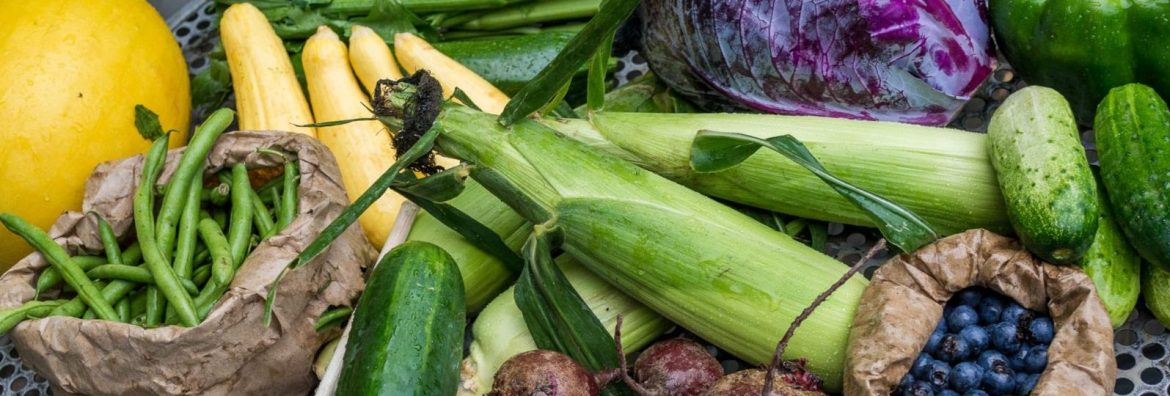Thoughts on approaching this week’s box from subscriber Conne Ward Cameron.
Just in time for the Fourth of July, corn arrives. Four ears in the box today but with luck, many more ears to come.
There’s lots of information on corn at https://grassfedcow.com/
My favorite way to prepare corn on the cob is grilled. And finally, this year, I did a story with America’s Test Kitchen and learned the way to easily remove the pesky silks from ears of corn. Maybe I could have figured this out for myself, but …..
Turns out if you grill the corn with the husk and all, then when you pull the corn off the grill, you just pull off the husk and the silks come, too. No fiddling around trying to pull off silks one by one. They just come off with the husks. Done.
Then, if you want the corn to have a little more direct char, just put the husks cobs back on the grill for a few minutes. The ATK folks also dreamed up a way to butter the corn easily. They mix up a flavored butter and put it in a little foil boat shaped like an ear of corn. Take your husked corn, roll it in the little boat to coat it in butter, then put it back on the grill for that final char. Any remaining butter can be served alongside.
I’m definitely grilling all my corn from now on. We usually have the grill going three or four nights a week so it’s no hardship to cook a few ears at the same time. Then you treat them just like you would a boiled ear of corn – kernels available for any manner of uses.
* * *
Food 52 put out this pickled corn recipe recently. You may not want it today when you’re enjoying those first ears, but if we find a dozen ears in a box one week, this could come in useful. It’s like a lot of pickled corn relish recipes, but pretty simple. And of course, if you don’t have a fresh bay leaf, a dried one will do.
Pickled Corn
1 1/2 cups fresh corn
1 jalapeño or serrano pepper, halved lengthwise
1 fresh bay leaf
3/4 cup white vinegar
1/2 cup water
1/3 cup sugar
1 tablespoon salt
Place the corn kernels, jalapeño halves and bay leaf into a 16-ounce jar. Set aside.
In a small pot, stir together the vinegar, water, sugar and salt. Place over high heat and bring to a boil. Once boiling, remove from heat and pour the hot liquid into the jar to cover the corn. Discard any remaining pickling liquid you may have left. Carefully place the lid on top of the jar and let sit until cool to the touch.
Once cool, place into the fridge and let chill overnight. Keep chill until ready to use.
* * *
I ran into this recipe today, one from the Splendid Table folks. It’s from a new book, Meera Sodha’s Fresh India, and I love the idea of the whole cobs in the soup. See https://www.splendidtable.org/
Gujarati Corn on the Cob Curry | Gujarati makai subji
1 cup unsalted peanuts, preferably red-skinned (plus extra to serve)
6 ears of corn
5 tablespoons canola oil
3/4 cup chickpea flour
1 cup plus 2 tablespoons plain Greek yogurt
1 1/2 teaspoons salt
1/2 teaspoon ground turmeric
1 1/2 teaspoons ground red chile
1 teaspoon sugar
First grind the nuts to a fine consistency in a spice grinder or food processor and set aside.
Next, husk the corn and pull off any silky strands. Make a deep horizontal cut halfway down each ear and break in half. Bring a pan of water to boil, add the corn, and boil for 6 to 8 minutes, until tender, then drain.
Put the oil into a large lidded frying pan over a low to medium heat and, once hot, add the chickpea flour, stirring continuously to smooth out any lumps. After around 4 minutes it will start to turn a pinkish brown. When it does, add the ground peanuts, turn the heat right down, and cook for 5 minutes, stirring frequently.
Add the yogurt, salt, turmeric, ground red chile, and sugar to the pan. Stir to mix, then increase the heat to medium. Slowly ladle in 2 1/2 cups of water, stirring until you have a smooth consistency.
Put the ears of corn into the pan, cover with the lid, and leave to heat through for around 5 minutes, until the sauce is the consistency of heavy cream. Transfer to a serving dish or individual bowls and scatter over some crushed peanuts. Serve with rice or chapatis and encourage people to use their hands.

